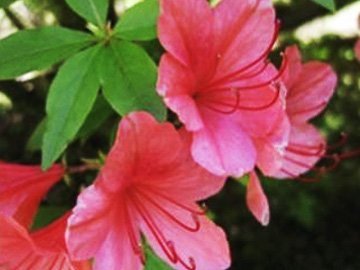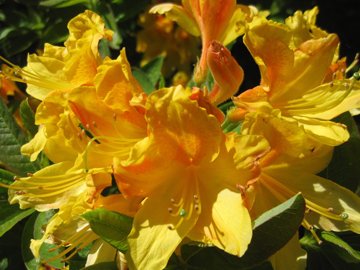Fern Collection
Plant Area Map — Fern Collection
About Ferns
シダ・羊歯 / Shida • A fern is a member of a group of vascular plants that reproduce via spores and have neither seeds nor flowers. It has true roots, stems and complex leaves. The number of known fern species is about 10,500, but estimates have ranged as high as 15,000 as new species are still being found in unexplored tropical areas. The ferns are ancient plants, some of them as old as the Carboniferous Period (beginning about 358.9 million years ago) and perhaps older. Their type of life cycle, dependent upon spores for dispersal, long preceded the seed-plant life cycle.
The ferns are extremely diverse in habitat and form. They range from tiny gauzy plants less than half inch in size to huge tree-like ferns 30 to 80 feet tall. Some are twining and vine-like; others float on the surface of ponds. The majority of ferns grow in warm, damp areas of the Earth. Growing abundantly in tropics, ferns decrease in number in higher latitudes and low moisture, and only a few are found in dry, cold places.
Tassel fern Polystichum polyblepharum
Areas C
Tassel Fern is an elegant plant forming a fountain of spreading, exceptionally lustrous, dark green fronds with finely divided but overlapping leaflets. The stems are covered in silver scales that contrast with the dark green leaves. Unfurling fronds sets this fern apart, lending an elegant look to shady gardens.
Native to Japan and North Korea, this shuttlecock-shaped fern is a great deer-resistant choice. Tightly coiled young fronds, or croziers, covered in golden hairs, emerge from the crown of the plant, their tips bend backwards and hang down like a tassel as they unfurl. The Latin specific epithet polyblepharum means “many eyelashes” and refers to bristles on the stipe and rachis (parts of the stem). This fern won the Royal Horticultural Society Award of Garden Merit in 1997.
SJG – Tassel fern photographed in Area C. It grows from under the rock left of the stone lantern; the bottom photo taken in spring when young fronds, covered in golden hairs, unfurl themselves down like tassels. (Map of the Garden at the bottom of the article)
Divided soft shield fern Polystichum setiferum ‘Divisilobum’
Area B
This medium-sized, evergreen fern is finely divided and does best in moist shade. Plants in the Polystichum setiferum ‘Divisilobum’ group are some of the most architecturally interesting evergreen ferns for the woodland garden.
The finely dissected evergreen fronds arch gracefully to 2’, creating mounded plants. As the fronds arch, they also appear to swirl around the center of the plant, creating a whirlwind effect. The soft green foliage looks good throughout the season and almost asks to be touched. It can be planted singly with other woodland perennials or used as a mass planting to soften a large area. It is a British fern known there as Soft Shield Fern, but commercially sold in the United States as the “Alaska fern”.
SJG - Soft Shield fern photographed In area B, in between large rocks. It doesn’t seem to be true to its usual mounded form due to its constricted placement
Western sword fern Polystichum munitum
Area B
It’s an upright fern which base (rhizome) supports bushels of sword-like lush foliage - sometimes up to 50 fronds per clump. The sori (spores) trace the margins of the leaves.The Western Sword Fern is unusually abundant in the Pacific Northwest and is very resilient, often seen along roadsides even in full sun. It survives droughts, but flourishes with consistent moisture and light sun, preferring cooler weather.
It was used as bedding and flooring and the large rhizomes were dug in the spring and eaten as a starvation food by the Quileute, Makah, Klallam, Squamish, Sechelt and other Native Americans. Also used in a traditional children’s game called “pala-pala” which involved seeing who could pull the most leaflets off a leaf in a single breath while saying “pala” with each one.
SJG - Sword fern photographed in Area B, where three of them are planted right past the rock formation, but they are present in virtually all areas of the Garden
Deer fern Blechnum spicant
Areas A, D, E, F, K ,Q, T, W, X, ZZW
This evergreen fern is native to temperate Northern Hemisphere (mainly Europe and western North America). Like some other Blechnum, it has two types of leaves: sterile and fertile. The horizontal whorls of the sterile leaves have flat, wavy-margined leaflets that are greatly reduced at the base. The annually shedding fertile fronds are taller and erect, with shiny ebony stalks up to one half of the frond length, with much narrower leaflets, each with two thick rows of sori (spores) on the underside.
This unusual fern is usually rabbit resistant. Deer fern provides valuable forage for Columbian and Sitka back-tailed deer, white-tailed deer, mountain goat, bighorn sheep, Rocky Mountain elk, Roosevelt elk, moose, and caribou.
SJG - Deer fern photographed in NE corner of Area B, but also present in Areas A, D, E, F, K ,Q, T, W, X, ZZW; the bottom pic shows characteristic two thick rows of sori (spores) on fertile fronds
Giant chain fern Woodwardia fimbriata
Area K
This species of fern ranges from Puget Sound to southern California and is common and impressive in the redwood forests of California. The genus was named in1793 after British botanist Thomas Woodward. It is native to north temperate zones and is characterized by foliage with partially netted veins and imbedded linear sori that resemble links of chain or chains of sausages, earning them the common name of chain fern. Fimbriata meaning fringed is a coastal species located in moist coniferous woodlands.
This fern grows from a stout and ascending rhizome as a stately clump with tall arching fronds that can grow to 4’ if sited well. It has plume-like fronds, several per crown with the bipinnate frond segments coarse and large, lacking the delicacy of smaller ferns, but persisting in excellent condition until new fronds have uncoiled. In cold winters, it will need protection.
SJG - Giant Chain fern photographed in Area K, on the corner of east and upper paths and behind the rock. According to California Native Plant Society it is the largest fern in North America, yet in our Garden it maintains modest medium size, probably due to being constricted by the rock, the tree and the path
Licorice fern Polypodium glycyrrhiza
Area V, ZZW
Licorice fern does not grow its fronds from a centralized location; this is in contrast to other ferns that grow their fronds from the same spot. The name Polypodium refers to this characteristic; it means "many-footed." The fronds are once-divided and triangular in shape, with finely-toothed margins and pointed leaflets. The rhizome is creeping and the fronds appear to have random placement, originating at various points. The glycyrrhiza refers to the pronounced licorice flavor of the rhizome: Glykys in Greek means sweet, while rhiza means root.
Licorice fern is one of those multitalented plants that occur naturally in several habitats. This water-loving, evergreen fern grows mainly in wet forests, where it is especially common as an epiphyte on the trunks of Big Leaf Maples. It can also be seen growing on logs, rock faces and wet, mossy ground. It is dormant in summer, showing off its beauty in winter. This fern was an important medicinal plant for a number of Native American nations, and was used raw, boiled, or baked. The rhizomes were chewed for their sweet licorice flavor and used as a remedy against colds, coughs, and sore throats—the cough drops of the time.
SJG – Licorice fern photographed in Area V, near stepping stones; also grows in Area ZZW. The bottom pic shows spores
Western maidenhair fern Adiantum aleuticum
Area ZZW
The Western maidenhair is one of the most graceful and beautiful of our native ferns. Bright green fronds open like the fingers of a hand perched atop contrasting wiry black stems. Gradually becoming a lush clump of uniquely horizontal and layered fronds, maidenhair softens the shade garden. Like other maidenhair ferns (150+ species scattered around the world) Adiantum aleuticum has delicate-appearing, airy leaves that evoke the traditional image of fern in the mind’s eye of the observer.
The genus name, Adiantum comes from the Greek, adiantos (unwetted), referring to how the leaves shed water. The Western Maidenhair fern is common in coastal areas from Alaska to California. Aleuticum is derived from the Aleutian Islands. In Washington state there are magnificent colonies above Willapa Creek along the nature trail at Lake Quinault. The blade of the Western Maidenhair is stiffly arching and sticks out longer than the adjacent stems like the middle finger of a hand, hence the colloquial common name of five-finger fern. Its fine foliage can grow to about 3’ high. The Eastern Maidenhair (Adiantum pedatum) is more fan-like.
Native Americans used the stems of Maidenhair Fern in basketry designs. They also used a tea made from the leaves as a hair wash. The Quinault burnt the leaves and rubbed ashes in their hair to make it long, shiny and black. Indigenous peoples of California used the stems for pierced earrings, either alone or with feathers; inserting them into the ear lobe to keep the hole from closing. The leaves were also chewed for internal wounds, chest pain, or stomach trouble.
SJG – Western Maidenhair fern photographed in south end of Area ZZW, close to stream; bottom pic shows leaf detail
Alpine water fern Blechnum penna-marina
Area X, Z
The Genus Blechnam is derived from the Greek word blechnon, which is an ancient name for fern. Commonly called Little Hard Fern, the dainty ferns fronds emerge as a deep copper color in the spring and transform to a glossy green color later in the season. It is evergreen and has two types of fronds – prostrate sterile fronds and upright spikes holding minute fertile fronds.
This water fern is one of the smallest ferns making it a popular choice used in Bonsai. Originally from the Southern Hemisphere (New Zealand, Australia & South America) It can be found at sea-level up to 3000 feet above sea-level. Unlike most ferns, it does well in low humidity, which makes for a good indoor houseplant.
SJG – Alpine Water fern photographed in Area X, but also grows in Area Z. The bottom pic shows young copper color frond
August 2021 • Patti Brawer, Joanie Clarke, Kathy Lantz and Aleksandra Monk @ SJG docent Plant Committee. Most pictures by Tony Monk. Thank you Ellie Szostalo for pictures of licorice fern and close-ups of deer, maidenhair and alpine water ferns. Information gathered from ‘The Encyclopedia of Garden Ferns’ by Sue Olsen & Elizabeth C. Miller Botanical Garden's website 'Great Plant Picks'













